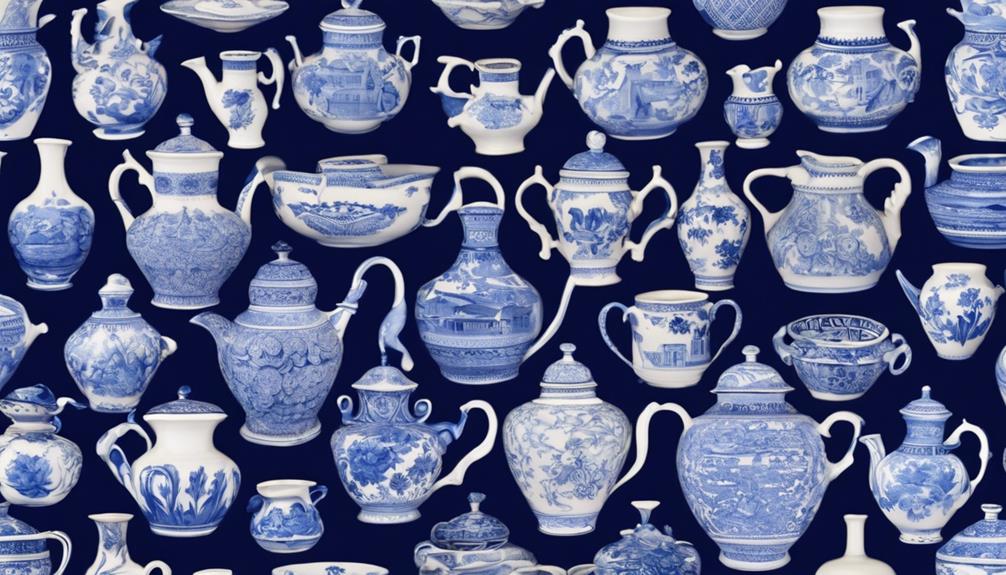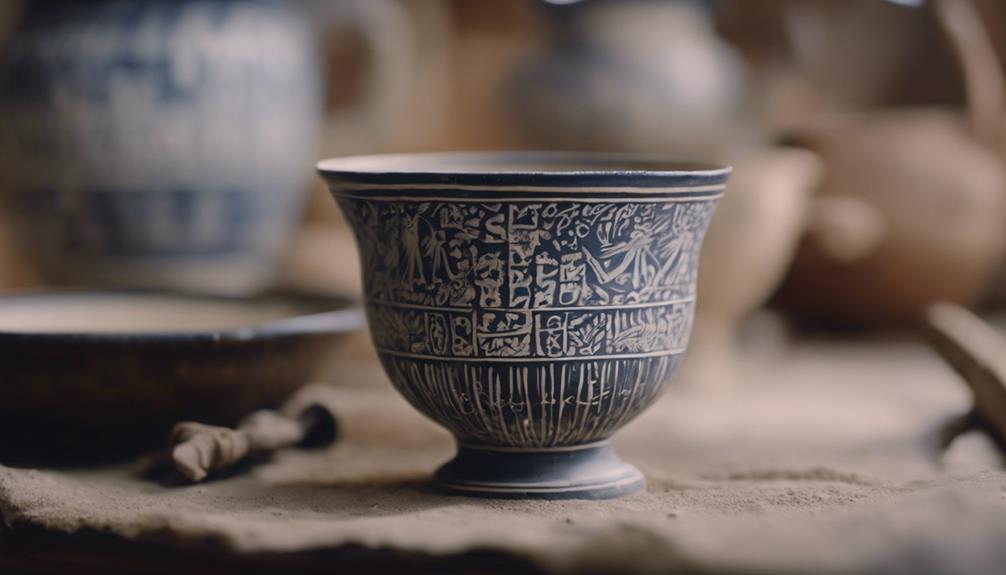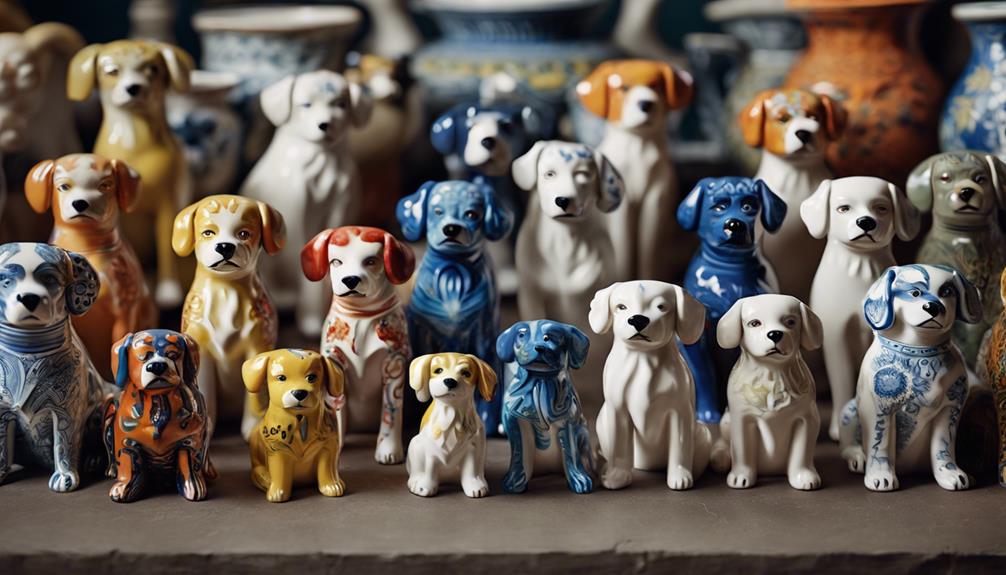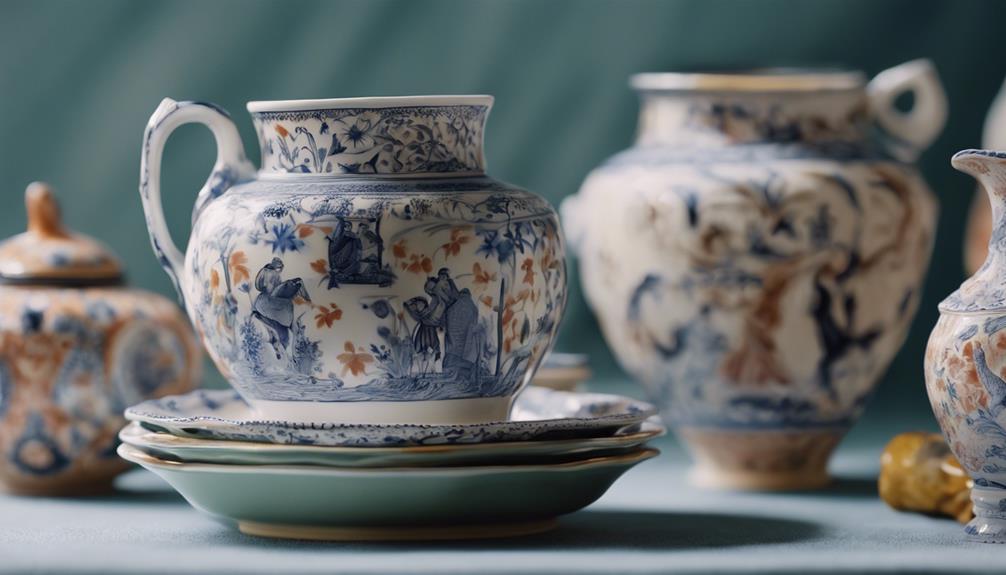Staffordshires Pottery History and Sights
Uncover the intriguing story of Staffordshire pottery, starting in the 17th century with elaborate designs and local clay. From renowned potters like Josiah Wedgwood to groundbreaking techniques like Jasperware, each piece reflects a fascinating history. Identify authenticity through distinctive marks and delve into the evolution of pottery dogs as symbols of loyalty. Admire well-maintained figurines, each carrying market value based on rarity and condition. Explore the sights of Stoke-on-Trent, immersing yourself in exhibitions that highlight craftsmanship. Learn about the cultural significance of clay and the dynamic ceramics industry. The legacy of Staffordshire pottery is ready for your exploration.
Key Takeaways
- Staffordshire Pottery originated in the 17th century with unique designs and skilled craftsmanship.
- Local clay deposits allowed for intricate designs and fueled industry growth.
- Notable potters like Thomas Whieldon and Josiah Wedgwood introduced innovative techniques.
- Staffordshire pottery dogs symbolize loyalty and protection, evolving from traditional to stylized designs.
- Explore pottery exhibitions and heritage centers in Stoke-on-Trent to appreciate the cultural significance of clay.
Origins of Staffordshire Pottery
Staffordshire pottery emerged in the 17th century, marked by its distinctive designs and skilled craftsmanship. The local clay deposits in Staffordshire played a vital role in the creation of these exquisite pieces. Potters in this region utilized handcrafting techniques to mold the clay into beautiful and durable pottery that soon gained popularity far and wide.
The artisans of Staffordshire honed their skills over the years, perfecting their craft to produce pieces that weren't only visually appealing but also practical for everyday use. These handcrafting techniques allowed for intricate designs to be carefully carved into the pottery, showcasing the talent and dedication of the potters.
As the demand for Staffordshire pottery grew, renowned potters like Josiah Wedgwood and Thomas Whieldon made significant contributions to the industry, further enhancing the reputation of Staffordshire wares. The combination of local clay deposits and expert handcrafting techniques established Staffordshire as a hub for quality pottery production, setting the stage for the industry's future success.
Development of the Pottery Industry
During the 17th century, the pottery industry in Staffordshire experienced significant growth driven by local resources and skilled artisans. Families in Staffordshire operated small pottery businesses independently, passing down the trade through generations without external financial support. The trade was esteemed, with sons often apprenticing under their fathers to master the craft.
However, as British pottery gained traction in European markets, Staffordshire potters encountered heightened competition. This led to pottery innovations and modernizations to stay relevant in the evolving market. Despite the external pressures, craftsmanship in Staffordshire remained consistent and high-quality from the 17th to the 19th centuries, solidifying its enduring legacy.
The blend of tradition and adaptation allowed the local pottery industry to thrive amidst changing times, showcasing the resilience and adaptability of Staffordshire artisans. The evolution of craftsmanship and the drive to meet European market demands propelled the industry forward, shaping Staffordshire's pottery history.
Famous Staffordshire Potters

Renowned for their innovative designs and significant contributions to the pottery industry, several potters from Staffordshire have left an indelible mark on the world of ceramics. These notable artisans have not only revolutionized the way pottery is crafted but have also established a lasting artistic legacy that continues to inspire aspiring ceramicists today.
—
| Notable Potters | Notable Innovations |
|---|---|
| Thomas Whieldon | Tortoiseshell, Agate, Jade, and Marbled ware designs |
| Josiah Wedgwood | Jasperware, Black Basalt, and Creamware |
| John Astbury | Salt-glaze and Lead-glaze earthenware |
| Family Traditions | Legacy of innovative pottery-making |
| Inspirational Source | Techniques and designs for aspiring ceramicists |
—
These potters have not only shaped the history of Staffordshire's pottery industry but have also left behind a rich tapestry of techniques and designs that showcase the region's unparalleled artistic heritage. Their contributions stand as a reflection of the enduring creativity and craftsmanship that define Staffordshire's place in the world of ceramics.
Types of Staffordshire Pottery
When exploring the diverse world of pottery from this region, you can encounter various types of Staffordshire pottery, each with its own unique characteristics and historical significance. Staffordshire pottery encompasses earthenware, stoneware, and porcelain.
Porcelain production started in the 1750s at Longton Hall, showcasing the county's innovation in ceramics. Earthenware, slightly porous and coarser than stoneware and porcelain, reflects the region's traditional pottery techniques.
Before Staffordshire pottery, Chinese porcelain dominated, making Staffordshire's contribution to ceramic history vital. Named after the English county of Staffordshire, this pottery is renowned for its distinct designs, patterns, and handcrafting styles.
The availability of local clay and coal played a pivotal role in shaping the different pottery styles in Staffordshire. Understanding the historical significance and influences behind these pottery types provides insight into the rich heritage of Staffordshire's ceramic industry.
Marks and Signatures

When examining Staffordshire pottery, pay close attention to the marks and signatures on the underside.
These marks often reveal vital information about the maker and the time period of production.
Identifying these marks is key to verifying authenticity and determining the age of the piece.
Identification of Pottery Marks
To identify pottery marks on Staffordshire pieces, examine the maker's initials or symbols typically found on the items. These collectible marks hold historical significance and are key for expert authentication. For instance, famous potters like Josiah Wedgwood had distinct and artistic symbols on their creations. By looking closely at these marks, you can unravel the origins and age of Staffordshire pottery. Variations in these marks can indicate different periods of production, offering valuable insights into the history of these pieces. Below is a table illustrating some examples of pottery marks found on Staffordshire pottery:
| Potter's Initials | Symbol | Period |
|---|---|---|
| JW | Unicorn | 1800s |
| MS | Crown | 1700s |
| AB | Rose | 1900s |
Authenticity Verification Techniques
For authenticating Staffordshire pottery pieces, closely examine the distinct pottery marks or signatures typically located on the underside of the item. When delving into the world of pottery mark analysis, consider these key points:
- Utilize authentication methods such as comparing the marks with known databases or reference books.
- Engage in signature tracing to link the mark to a specific potter or pottery company.
- Conduct provenance examination to uncover the history and origin of the piece.
Understanding these techniques is vital for accurately determining the age, maker, and value of Staffordshire pottery collectibles. By mastering these methods, you can confidently authenticate and appreciate the rich history behind each piece you encounter.
Royal Staffordshire Pottery
Founded in 1793, Royal Staffordshire Pottery boasts a rich legacy of crafting commemorative ware for significant events throughout history. The pottery has seamlessly blended traditional craftsmanship with modern innovations, evolving through styles like Art Nouveau and Art Deco. This fusion of old and new hasn't only preserved its cultural significance but also garnered global recognition for its unique designs and high quality.
Visiting Middleport Pottery offers a firsthand look at the working Royal Staffordshire factory and museum, where you can witness the intricate pottery-making process. Despite embracing modern technology, Royal Staffordshire Pottery remains committed to upholding its traditional craftsmanship, ensuring the production of diverse and exceptional ceramic creations. This dedication to quality has made Royal Staffordshire Pottery a sought-after collectible among pottery enthusiasts worldwide.
Staffordshire Pottery Dogs

Staffordshire Pottery Dogs, also known as Staffordshire dog figurines, have a rich history originating in 19th century England. These ceramic figurines come in various popular designs and colors, symbolizing loyalty and companionship.
Collecting Staffordshire dog figurines is sought after for their charm, historical significance, and decorative appeal in both traditional and modern settings.
Origins of Pottery Dogs
Pottery dogs, also known as 'comforts' or 'hearth dogs,' have a rich history as popular decorative items in Victorian households. These figurines, often depicting spaniels or other breeds seated in pairs, were mass-produced in 19th-century Staffordshire, England. They symbolized loyalty, protection, and prosperity, serving as charming guardians of the home.
The artistic evolution of these pottery dogs saw them evolve from traditional hunting dog figures to more stylized and intricate designs, reflecting changing tastes and trends. Over time, they became not just ornaments but cherished symbols of good fortune and companionship. Their enduring appeal lies in their ability to evoke a sense of nostalgia and warmth, making them coveted pieces for collectors seeking a connection to the past.
Popular Designs and Colors
Featuring a myriad of intricate designs and vibrant colors, the popular Staffordshire pottery dogs captivated Victorian households with their charm and symbolism. These iconic figurines often depict King Charles Spaniels or other breeds in pairs, adding a touch of elegance to any room. The colorful variations and unique designs make them stand out as collectible pieces that hold sentimental value for many.
Staffordshire dogs were mass-produced and exported worldwide during the 19th century, becoming a staple in homes across different continents. Today, these figurines continue to be sought after by collectors who appreciate their nostalgic appeal and historical significance. The market value for well-preserved Staffordshire pottery dogs remains strong, reflecting the enduring popularity of these charming pieces.
Collecting Staffordshire Figurines
Indulge your passion for collecting by seeking out authentic antique Staffordshire figurines, particularly the beloved dog figurines that have captured the hearts of enthusiasts for centuries.
When delving into the world of Staffordshire pottery dogs, keep in mind the following:
- Pricing trends: The value of these figurines can vary greatly based on factors like rarity, condition, and demand within the market.
- Restoration techniques: Understanding how to properly restore Staffordshire figurines is essential to maintaining their value and preserving their beauty for future generations.
- Authenticity challenges: Identifying genuine antique Staffordshire dog figurines amidst reproductions can be tricky, so it's important to educate yourself on the telltale signs of authenticity.
Identifying Staffordshire Pottery

To identify genuine Staffordshire pottery pieces, you should closely examine the distinct pottery marks typically found on the underside for accurate recognition. These pottery markings serve as authentication, ensuring you have an original piece.
If you come across antique pottery lacking marks, seeking vital advice is imperative to guarantee accurate identification. Look out for common makers' marks like a knot motif with initials, as they can help in dating Staffordshire pottery accurately.
Genuine Staffordshire pieces often feature brightly painted designs and a clear glaze, making them easily recognizable. Additionally, pay attention to the sturdy body construction and even glaze appearance, as these are key attributes to look for when identifying Staffordshire pottery.
Sights in Staffordshire Pottery
You can explore various attractions related to Staffordshire pottery, immersing yourself in the rich history and artistry of this renowned craft. When visiting Staffordshire, be sure to check out:
- Pottery exhibitions, tours: Visit Middleport Pottery in Stoke-on-Trent to witness Royal Staffordshire pottery being made, or head to The Potteries Museum & Art Gallery in Hanley to marvel at the world's greatest collection of Staffordshire ceramics.
- Artistic techniques, craftsmanship: At Moorcroft Heritage Visitor Centre in Burslem, admire the intricate designs of handcrafted art pottery, or stop by The Emma Bridgewater Factory in Stoke-on-Trent to get a glimpse into the production of iconic English pottery.
- Cultural significance: Discover the importance of clay in the ceramics industry at LoveClay Ceramics Centre within Valentine Clays headquarters, where you can learn about the role of clay in creating beautiful pottery pieces.
Conclusion
To sum up, Staffordshire pottery has a rich history dating back centuries, with renowned potters and a wide variety of distinctive pieces.
From the iconic Staffordshire pottery dogs to the detailed marks and signatures, there's much to explore and learn about in this captivating realm of ceramics.
Whether you're a collector or simply intrigued by the history of pottery, Staffordshire provides a glimpse into a vibrant and enduring tradition that continues to captivate enthusiasts worldwide.

